Table of Contents
New SharpCharts Workbench
Looking to take better control of your financial well-being? Whether you’re a newbie or an experienced investor, a long-term investor, or a short-term trader, StockCharts’ SharpCharts Workbench has the tools to help you become a confident investor.
Every day, the stock market presents opportunities to make money. You can’t chase every opportunity and won’t win on every investment. What you can do is find what works well for you. And that requires an investment in time and patience.
The first step: Log in to your StockCharts account and explore the various tools and features you can use to simplify your investing journey. And if you don’t have an account, consider signing up for a free trial.
The New SharpCharts Workbench is an updated version of the classic SharpCharts, the most popular charting tool for StockCharts users. The learning curve isn't steep if you’re familiar with the classic SharpCharts. You’ll recognize the features quickly and become a pro in no time.
Navigating the New SharpCharts Workbench
After you log in to your account, from Your Dashboard, under Member Tools, click on SharpCharts (you’ll find it in the Charting Tools section). You could also select New SharpCharts from the dropdown menu under Default Charting Tool.
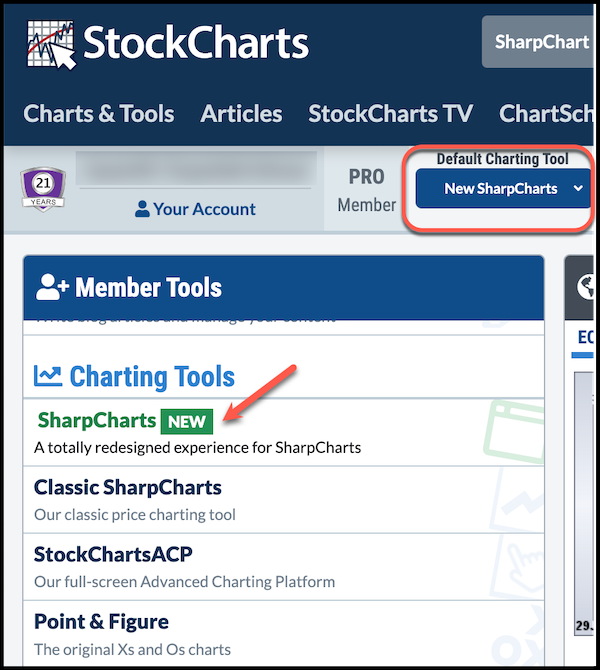
How To Create a SharpChart
Stock prices move because of supply and demand pressures. There are a lot of factors that affect a stock's price move. It could be earnings, interest rate decisions, or economic conditions. Sometimes, investors hype up stocks for no good reason. Because different factors impact price moves, it's important to visualize these price moves using charts. The tools and features available in SharpCharts help you identify trends, patterns, support and resistance levels, and much more to make you a more empowered investor or trader.
Ready to get charting?
There are a couple of different ways to bring up a SharpChart, but to keep it simple, start with the following:
- Enter a ticker symbol (if you don’t know the symbol, start typing the name of the security) in the “ChartBar” at the top of every page on the StockCharts website.
- Select SharpChart from the dropdown menu on the left (if it’s not selected)
- Press Enter or click Go.

The main window will display a default style chart, although you can always create your own. Note the dropdown menus across the top of the chart.
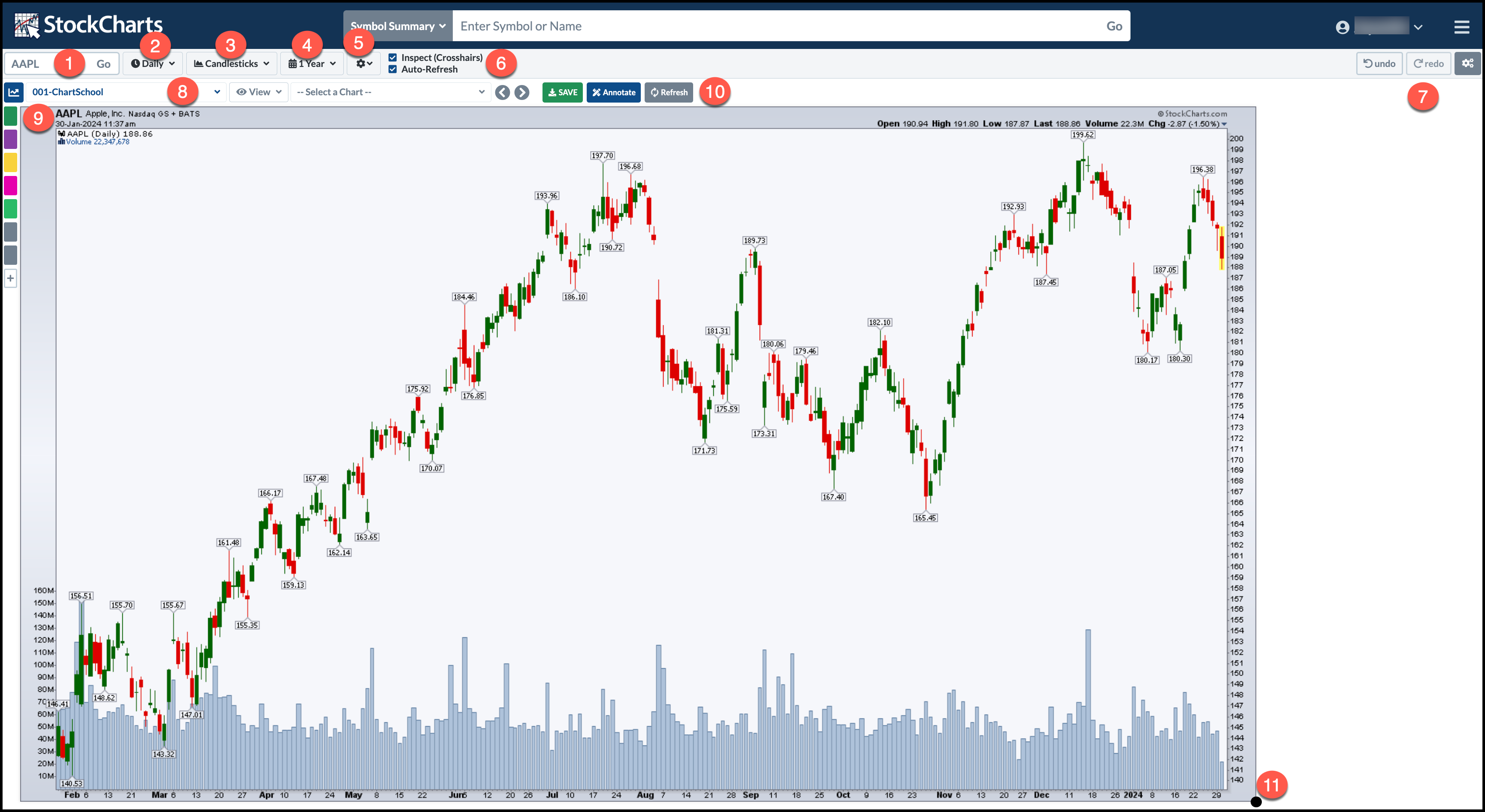
1- Symbol. Enter a symbol in the main ticker symbol box. The chart associated with the symbol is plotted in the main price plot area.
2- Chart Period. Select the chart period from the dropdown menu—daily, weekly, monthly, etc. StockCharts members have access to more chart periodicities, including intraday periods such as 1-, 2-, 5-, 10-, 30-, 60-, and 120-minute charts, as well as monthly and yearly charts. Check out our Support Center section on Data Bar Periods for more info.
3- Chart Type. Do you prefer line charts, bar charts, candlesticks, or something else? The dropdown menu has plenty of choices for you to choose from.
4- Range. Select the time frame for your charts—one day, month, year, or a specific range. There are several choices; you can enter your start and end date.
5- Chart Settings. Customize your charts by selecting the range, size, color scheme, color of the bars on your chart, volume display, legends, grid style, scale, appearance of candlesticks, and so on. Click on Chart Settings to see all your choices (see below).
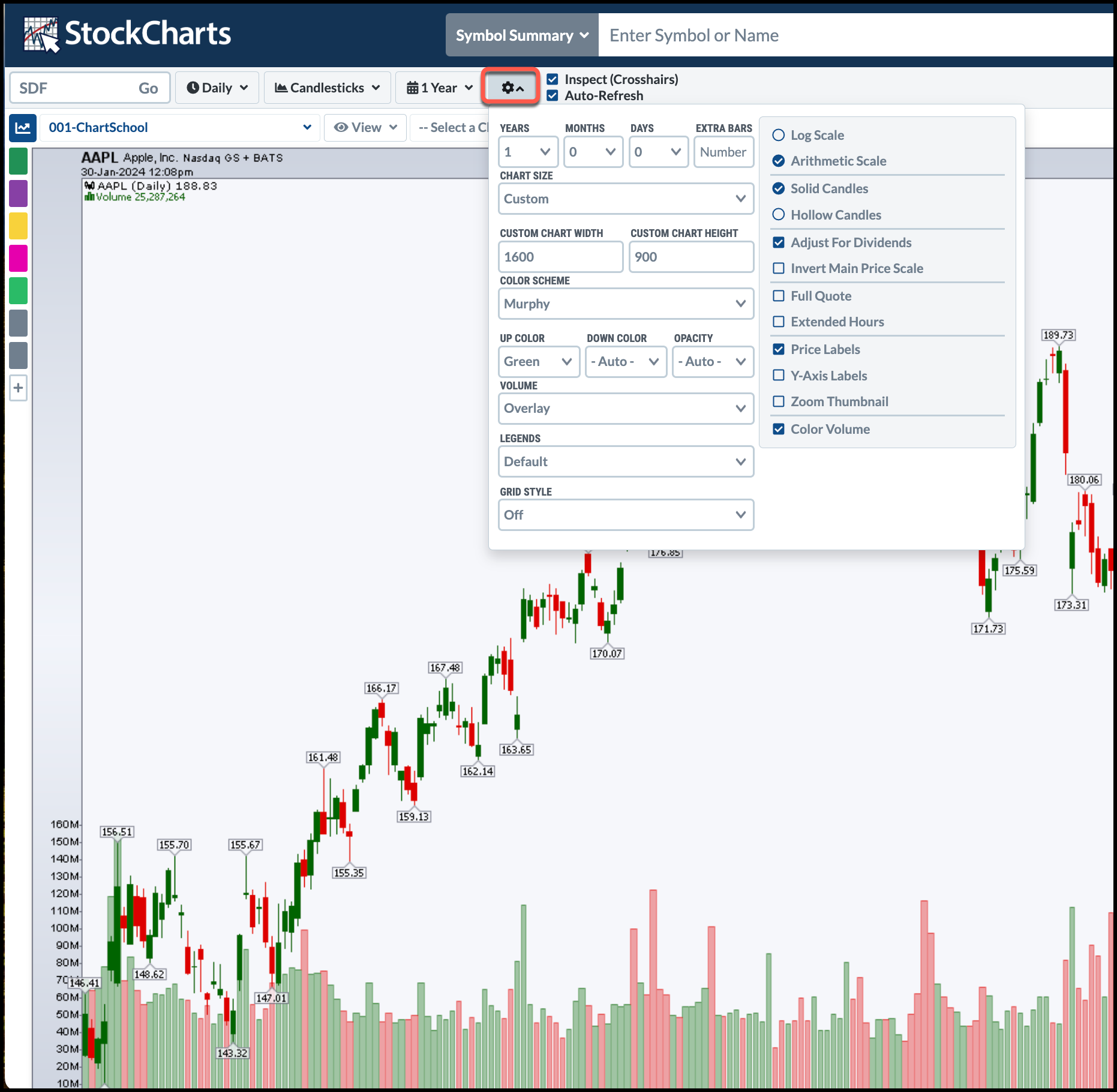
6- Inspect and Auto Refresh. Want to know the date and price of a specific price bar? Check the Inspect box to see the crosshairs on a chart. Move the crosshairs so the vertical crosshair lines up with a specific date and the horizontal crosshair lines up with the indicator or overlay value for that date. If you hover over a price bar with the Inspect checked, you’ll see the open, high, low, close, volume, and approximate position of the crosshairs on the vertical axis (Y).
The Auto Refresh box is checked by default. If, for any reason, you want to pause the refresh, just uncheck the box.
7- Undo, Redo, Settings. Want to undo the last action you added to your chart? Click the Undo button. And if you undo something and want to redo it, you only need to click the Redo button. The settings button (gear icons) allows you to center or left-align your chart and auto-size your charts. The Auto-Size feature is handy for viewing your charts on your phone or tablet. All you need to do is slide the Auto-Size Charts button to the right, and your charts will automatically fit on your phone or tablet.
8- ChartLists. The next row displays your ChartLists. From here, you can select a ChartList and then horizontally scroll through all the charts in the selected ChartList. A new addition to CharLists is the Load Symbol Only choice. When this button is checked, only the ticker symbol will be changed on the chart as you go through the saved charts in your ChartList.
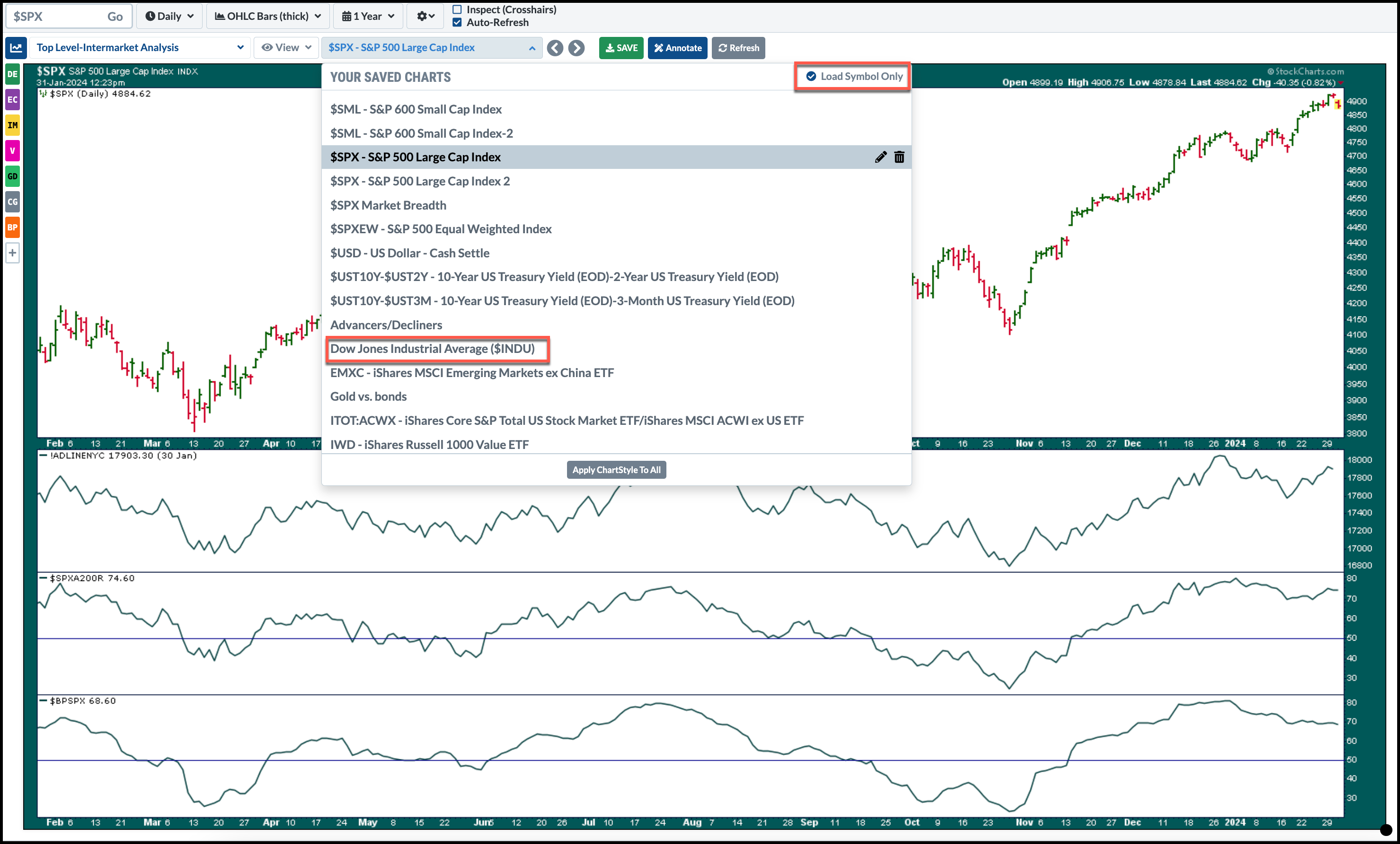
9- StyleButtons. Want to access your most frequently used ChartStyles quickly? Save your most used ChartStyles using the StyleButtons on the left of the chart panel. Customize these buttons by changing their position and adding colors and labels to identify the different styles easily. Once you do that, you can access your most used CharStyles with one mouse click. You could also click on the blue chart icon above the StyleButtons to view your ChartStyles as a list and select your default style by clicking on the star next to the ChartStyle name.
10- Save, Annotate, Refresh. When you’ve got your chart the way you want, don’t forget to save it (click the green Save button). The Annotate button allows you to add trendlines, text, Fibonacci levels, and other drawing tools to your SharpChart. More on these tools later. If you’ve got your Auto-Refresh button checked, then the chart will automatically refresh. But if it’s not checked, and you want to see the most recent data, click the Refresh button.
11- Resizing Charts. A feature you don't want to ignore is the ability to resize charts by dragging. Click on the black dot in the bottom right corner and drag it to resize the chart.
Ready to sharpen your chart analysis skills and become an empowered investor or trader? Let's dive into the nuts and bolts of the SharpCharts Workbench.
SharpChart Chart Settings
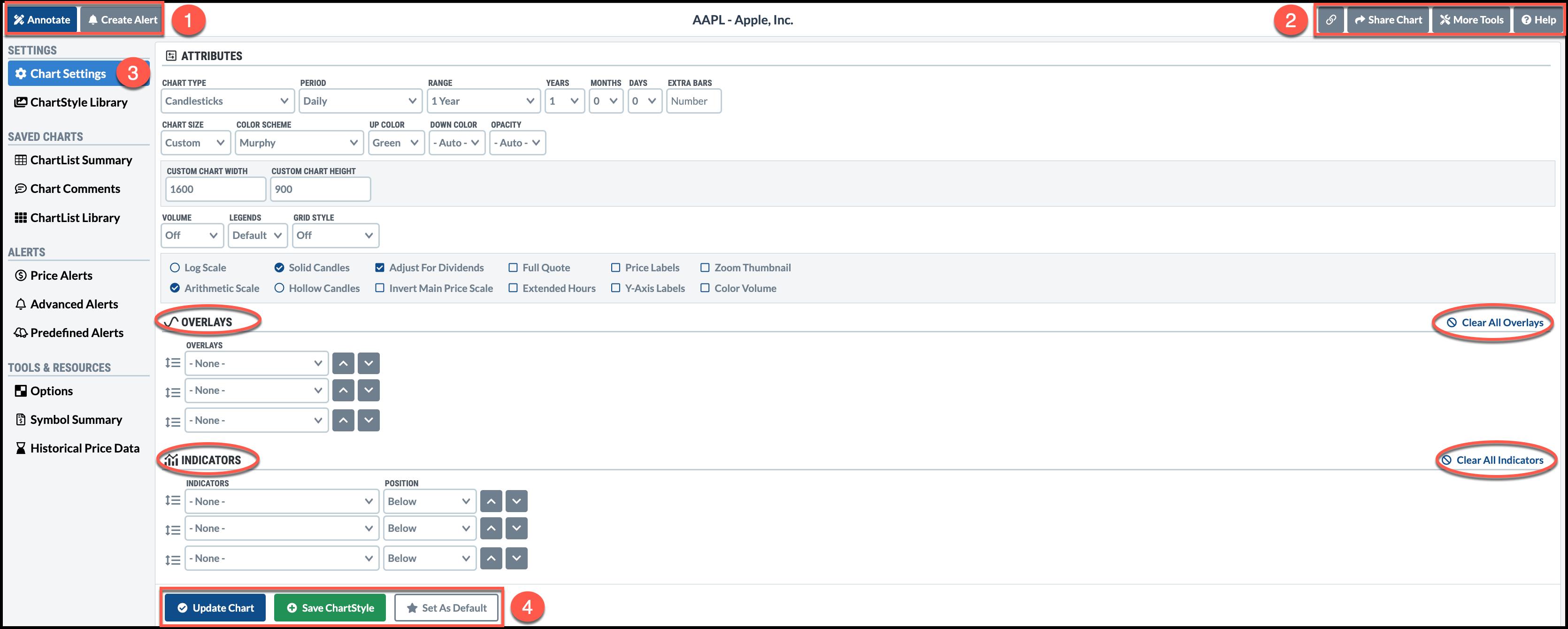
1- Annotate, Create Alert. The Annotate button (also known as ChartNotes) gives you access to drawing tools such as trendlines and parabolas. You can add text, Fibonacci levels, and other drawing tools. Before exiting ChartNotes, you’ll have the opportunity to save your annotations. Be sure you save your chart in a ChartList after you add the annotations if you want to revisit the chart. This is also a great time to create an alert, which you can do by clicking the Create Alert button.
2- Link, Share Chart, More Tools, Help. Once you’ve created a chart, you can create a link to the chart which you can bookmark, save, or share. Want to share the chart with your social media followers? Click the Share Chart button and send it to your X, Facebook, or LinkedIn. You could also link to a chart, download the image, email, or print a chart.
Access other tools such as Create Alerts, switch to Classic SharpCharts, Symbol Summary, ACP, Point & Figure charts, GalleryView, Seasonality, Options, PerfChart, and RRG charts.
If you have any questions about an overlay or indicator, the Help button is your portal to an array of support tools available from StockCharts.
3- Chart Settings. This is where you can change your chart Attributes, add Overlays, and add Indicators.
Some of the attributes are duplicates of the settings above the chart. If you wish to change any chart attributes, especially after adding indicators and overlays, there’s no need to scroll back to the top of the chart. You can do it from this section that resides below the chart.
In the SharpCharts Workbench, you have a ton of flexibility in your Chart Settings. You can change your chart type, timeframes of charts, size, colors, and amount of info you want displayed on a chart.
Below the Attributes section, you can add overlays and indicators to your charts. Note you can reposition the overlays and indicators using the drag-and-drop icon on the left of the overlay and indicator names.
- Adding Overlays. You can select from a list of overlays from a dropdown menu and select the parameters, style, color, and opacity of the different overlays.
- Adding Indicators. From here, you can select indicators to display on your charts, their parameters, position, and various other aspects of the indicators.
If you wish to delete your overlays and/or indicators, click Clear All Overlays or Clear All Indicators on the right.
4- Update Chart, Save ChartStyle, Set As Default. Once you’re done selecting your chart attributes, adding overlays, and adding indicators to your charts, click Update Chart. Your chart will be updated with your selections.
You want to save your favorite ChartStyles to use them on other symbols in the future. To save the ChartStyle, click the Save ChartStyle button. Click the Set As Default button to save the ChartStyle you created as your default chart.
Now that you have a basic understanding of the Chart Settings, let's move to the ChartStyle Library.
Next Up » SharpCharts ChartStyle Library